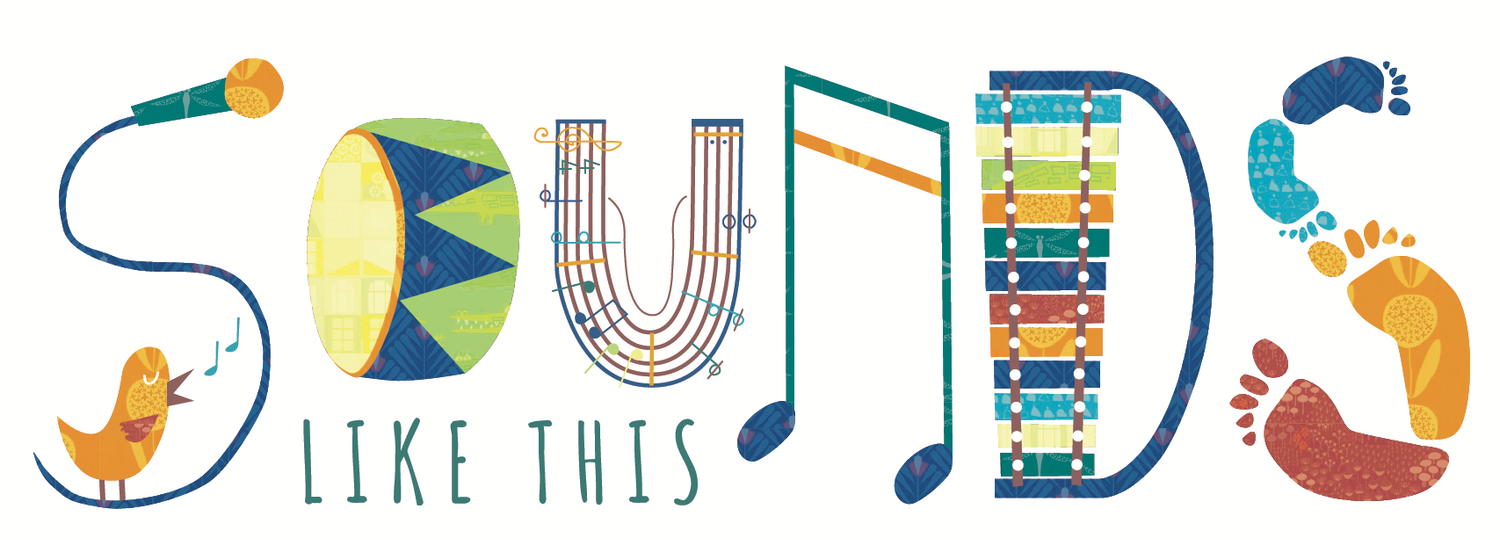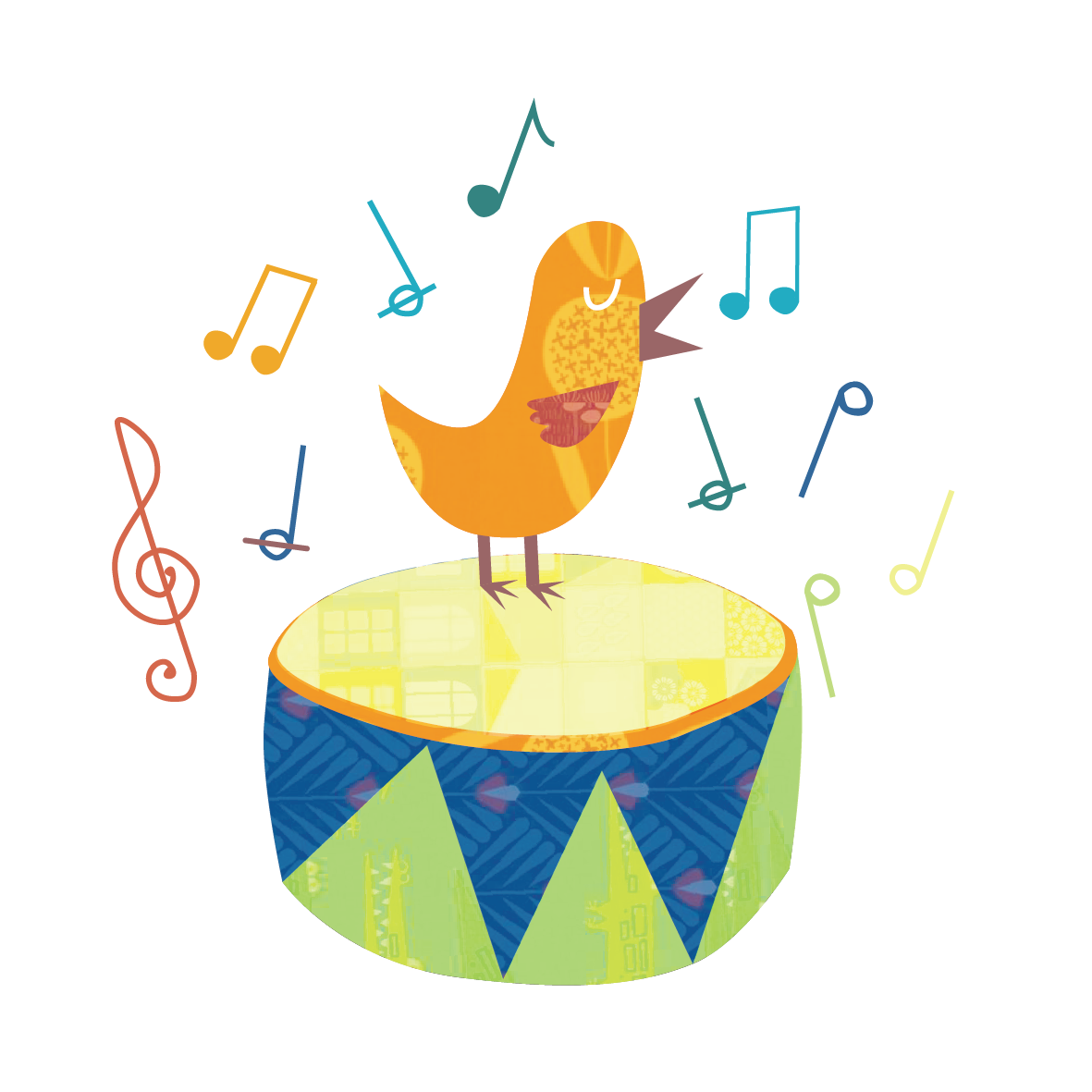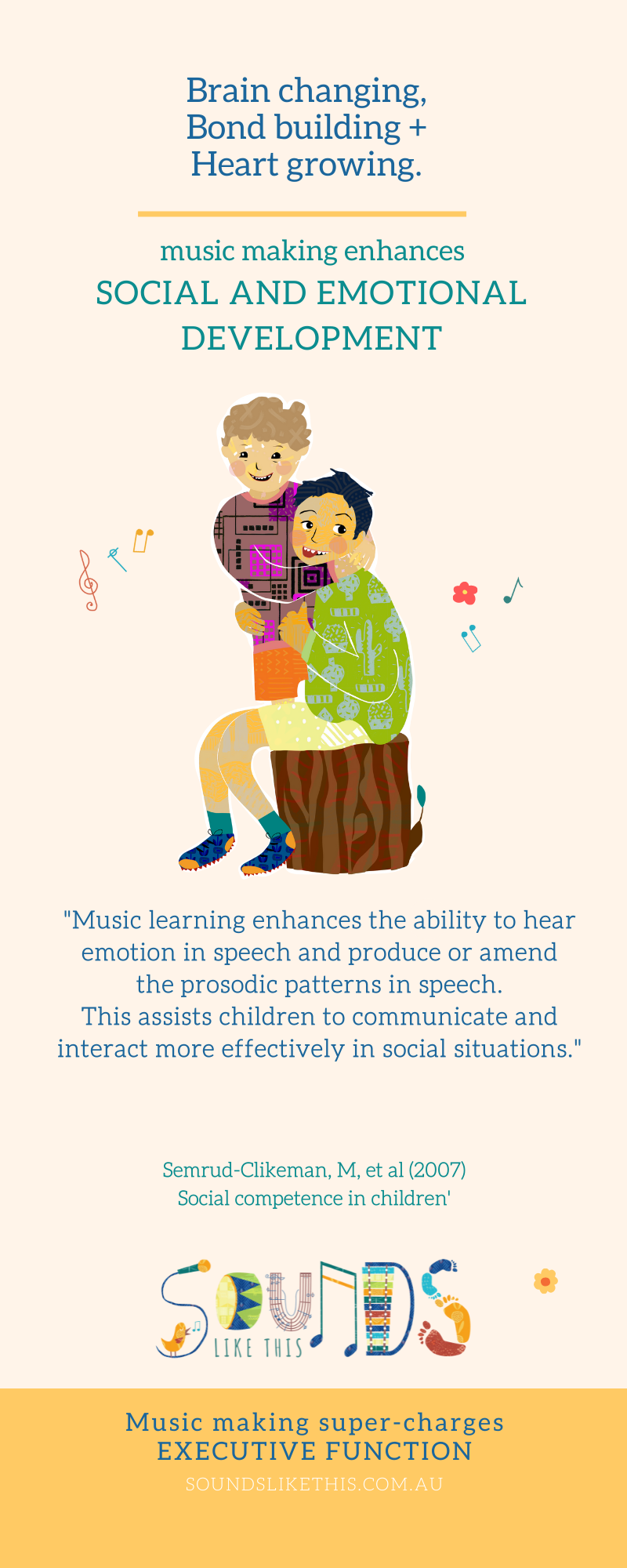Using Music for Social Emotional Learning in Your Early Learning Setting
In a real-life experiment, a teacher asked 7-year-olds to line up and complete an exercise together. The reward for a successful mission? Early admission to lunch and playtime.
The teacher instructed the students to pass a steady beat down the line without missing a student or a clap. You can imagine how difficult that might be for a bunch of 7-year-olds.
It means they need to activate their inhibitory control, power up their visual, auditory, and motor cortices, and predict the beat so they can clap when called upon to avoid letting down their classmates. They also have to share and take turns.
It took the class five goes but by learning to cooperate, provide supportive encouragement, and make decisions together, they did it!
This experiment shows how powerfully music can help with social and emotional learning, or SEL. Studies show SEL can help boost a child’s self-esteem and give them the right skills, attitudes, and behaviours to handle everyday challenges.
So let’s dive into that in more detail and explore some musical SEL activities you can start implementing in your early childhood setting today.
The benefits of music for social emotional learning
We already know that music has a big impact on helping young minds grow and change. But we’re only just starting to appreciate how good musical learning can be for early childhood social emotional learning (SEL).
Music and emotional development
Mothers sing their babies to sleep without even thinking about it. But both the gentle rocking and the lilting intonation simulate rest and sleep. It’s so effective that studies show babies physically calm down when they hear a parent’s or guardian’s singing.
Active music making is a great tool for children too. It helps them recognise, express, and release their emotions. And a 2017 study even found that singing in low-stress situations significantly lowers cortisol and cortisone levels in the body; it reduces stress!
Simple songs like Pop Goes the Weasel or a rhyme like This Little Piggy also help familiarise children with suspense and then help them release that tension.
Then there’s the self-regulation skills they learn from musical games. They have to learn to wait, carefully listen, or switch between fast and slow and loud and soft, and so much more.
Music and social development
Music is such a good tool in a young child’s social development. Music and singing encourage infants to create secure, trusting relationships with other people—not just with their parents (naturally!) but also with friends. One University of Toronto study even found music helps children bond with strangers.
I’m sure I don’t need to tell you how lullabies can decrease crying episodes. But studies have shown the simple act of a mother singing to her child also boosts bonding and decreases maternal stress.
In an early learning centre, calm and settled babies have an impact on almost everyone! Calm babies means your educators are less stressed and your parents are reassured knowing their precious little ones are in safe hands.
Musical games often teach growing minds about social rules, such as turn-taking, role-playing, sharing, or leading and following. When children make music together, they’re also learning about team-building and cooperation.
Even more importantly, playing musical games in a safe space helps children learn that their contributions are significant and meaningful. This is a big part of the Belonging, Being, Becoming Early Years Framework in Australia, ensuring that “when children have positive experiences they develop an understanding of themselves as significant and respected, and feel a sense of belonging”.
4 easy music activities to do in your early learning setting for social-emotional learning
1. Create a beat together to form bonds and create community
2. Encourage children to clap or tap out a beat on instruments. Such a simple activity synchronises their minds and bodies.
3. Collective music-making helps build bonds not just between the children, but between children and educators, and even between your team members.
4. Making music together requires your team and children to synchronise with each other musically, which studies have found releases endorphins in the brain and leads to more positive social feelings towards one another.
It’s a wonderful way to build a cohesive team in your early learning centre and enhance working relationships.
Try some musical stop-and-go activities to improve self-regulation
Stop-and-go activities are all about letting the children shake out any pent-up energy while also controlling their movements.
Play a song or an instrument and encourage the children to dance and move freely until the music stops. When it does, they have to FREEZE! Musical Statues is a great example of this and if you want to infuse it with a colour-finding game for toddlers and preschoolers, Witchetty Jamboree is a must!
This SEL musical activity helps them learn to flex their inhibitory control muscles, as well as anticipate, predict, and react by following cues to start and stop their bodies.
Building those inhibitory control muscles goes beyond physical development. It also has links to intellectual benefits. Every person needs to learn to sort through daily info, learning what information is relevant and irrelevant to handle in any single task.
“Inhibitory processes are at the core of intellectual development because better developed inhibitory control results in less intrusion of task-irrelevant information and more efficient handling of contextually appropriate information.”
Create a soundtrack for your classroom to establish routine
Use your voice, or play music throughout the day to teach about routine and transition. You can make up songs for virtually any regular activity.
Start and end the day at childcare or in your early learning setting with a Hello and Goodbye song children will love and anticipate. It’s a beautiful way to set the tone for learning.
These routine songs may also include a Pack Up song to act as an auditory cue, enabling easier transitions for those children who need a little more time.
Use this pack-up song regularly for a clean and room and happy little helpful Vegemites.
They can easily be incorporated into regular routines for tasks that occur frequently, like washing their hands before they eat. This one is sure to keep their listening ears on, their detective skills honed, and the bathroom line moving without congestion.
Sing echo songs to encourage turn-taking
Vocalisation games and echo music activities are a wonderful way to display the act of turn-taking as the basis for respectful communication. Simple echo games build self-esteem as the children learn that their contribution is worth being heard and valued.
Vocalisation games can start even with the littlest babies and involve replicating the little squeezes and babbling noises they make. Babies quickly recognise the back-and-forth nature of conversation and communication and their role within it.
As babies reach a few months of age, you can start to build on the sounds they make by exaggerating the noise, changing the tone, or changing the direction of the sound, for example.
Instead of just talking at them, they can see that you’re waiting and responding to the noises they make, which helps them understand that their contribution is valued—such an important component of the Being aspect of the Early Years Framework.
Once children are a little older and have started speaking, you can start playing Echo Songs, in which you can alternate between the children and the educators singing a beat, word for word, and pitch for pitch. This reinforces the essential parameters of communication: speaking AND listening (so important!).
Echo songs also help young children learn how to match pitch, improve their language skills, and work alongside others. Sometimes they can include musical movements for the children to mirror, which also helps improve gross motor skills, such as with the Hang About song.
To take it a step further, once children have mastered the concept of echo games, they can lead. If it's a new song or vocalisation that they’re making up they can do no wrong. Just being brave enough to try is a reward.
Find more inspiration for your early learning setting today
We know how difficult it can be to find new musical ideas and inspiration for your early learning setting. That’s why we’ve created a 5-minute guide to help you add music-making to your early learning setting in a better way.
Get our free tutorial for early learning settings today and:
Start building a connection with your children through music.
Find out how to scaffold the learning by building on songs.
Discover your voice
Learn a fun and simple new song the children will love.






